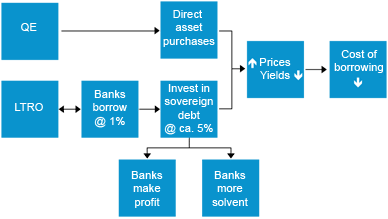Quantitative easing (QE) seems like a magic remedy whereby central bankers conjure up money out of thin air and use it to purchase assets. Such activity has the capacity to transfer toxic debt, stimulate demand for risk assets, devalue currencies – thus deflating debt – and maintaining low interest rates on government securities.
The European Central Bank’s (ECB) restrictive mandate does not allow it to print money (as opposed to countries’ central banks) for any other purpose than lending, so QE is out of the question. Mario Draghi, President of the ECB, can therefore be said to have demonstrated the new resolve of the central bank under his leadership in unveiling his longer-term refinancing operation (LTRO) program within 8 weeks of taking office.
As we have seen in the case of Hong Kong in 1998 and Switzerland in 2011, decisive central bank intervention sends a message to the markets that there is a willingness to do whatever is necessary to achieve something that is worth fighting for.
Conversely, earlier ECB bond purchases were an indication of the weak resolve which caused the markets to gorge on negativity. LTRO delivered an infusion of liquidity at a critical time. Without it, a lot of otherwise solvent banks would have remained in a perilous position. However, structural issues remain and need to be addressed while the support of central bank liquidity is in place. Otherwise LTRO will simply prove a case of throwing good money after bad.
LTRO: An ingenious spin on QE
Source: Bank of England for illustrative purposes only.
LTRO ingeniously makes use of the Basel II accounting rules which allow sovereign nations in the European Economic Area a zero interest rate lending facility. Consequently, the ECB can lend unlimited quantities of funding to European banks, at a nominal interest rate, in the knowledge that there is more than one incentive for these banks to purchase government debt.
Firstly, banks can make easy profits from capturing the differential between the interest charged on the borrowed money and the yield in the government debt. Secondly, they can bolster their balance sheets from a regulatory perspective. Moreover, in buying sovereign debt the banks help achieve one of the critical aims of QE in maintaining low borrowing costs for indebted governments.
LTRO has also provided a timely boost to banks in their attempts to raise capital to satisfy an increasingly penal regulatory agenda. The launch of the program came just four days before the deadline for banks to submit plans for raising the cash needed to maintain capital adequacy levels.
More treatment is needed
Nevertheless, a boost in liquidity, like most pharmaceutical drugs, only works effectively in conjunction with complementary measures. This contrasts with the example set by the US in March 2009, which used the Fed inspired rally to launch gazillions of equity.
At the national level, the rescaling of the Spanish budget deficit is challenging the resolve that is required for markets to believe in the planned reforms. The central bankers will be again solicited to control the markets, testing the government’s resolve. This is a perilous exercise at the best of times which is likely to be exacerbated by electoral and sporting distractions this summer!
In terms of further LTRO usage, most Spanish debt raised has been bought by domestic banks, and cross border confidence has not been boosted for long. Indeed, a variety of sources suggest that foreigners have used this window to divest from Spanish government bonds, and the domestic banks have been left mopping up the inventory, albeit with an attractive carry.
There is also increasing evidence that most of the monies from the LTRO have been spent or earmarked, more quickly than the markets thought, and we will soon need the next measure to prevent rates rising excessively in the periphery. As the private sector has already used a lot of its purchasing power, central bankers will soon, in spite of their reluctance, find themselves needing to buy government debt in the secondary market.
How they do it and what it leads to is important. There is a variety of tools they can use, from securities market programs (SMP) to a relaxation of ‘haircuts’. They can also allow Spanish banks to issue government guaranteed debt, essentially creating ECB eligible collateral, similar to what Italian banks have been able to do. SMPs were stopped after the LTRO, but can be reactivated, possibly sooner rather than later, as the markets need to understand the central banks are committed to preventing rates from spiralling out of control.
This summer has the added volatility of important and undecided elections, as well as distractions from football to the Olympics, that increase the risks of spikes on low volumes. Market interventions will need to be more stringent as a consequence.
Theoretically, there are few limits to what the ECB can do. They will likely test the market limits, as investors look through temporary fixes, and political limits, in respect of how much money the ECB can effectively create. This will test the resolve of politicians and central bankers from the north.

